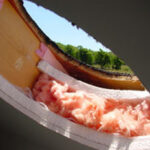There are three options that I know of:
- You can remove the interior ceiling surface and install ventilation baffles between the rafters before adding insulation;
- You can remove the ceiling and completely fill the rafter cavities with spray foam;
- Or you can add insulation on the inside of your existing ceiling, then add new drywall over top.
 The baffle method is time consuming to create, but good because it allows air movement that keeps roof surfaces cool in summer. The spray foam method packs a lot of insulation into the roof structure, but the roof surface will become very hot in the sun. Traditional organic asphalt shingles will fail prematurely under these conditions, though fiberglass asphalt shingles last well.
The baffle method is time consuming to create, but good because it allows air movement that keeps roof surfaces cool in summer. The spray foam method packs a lot of insulation into the roof structure, but the roof surface will become very hot in the sun. Traditional organic asphalt shingles will fail prematurely under these conditions, though fiberglass asphalt shingles last well.
Adding insulation panels to the inside of the existing ceiling means you lose some interior space, but it’s very effective and also eliminates the need for a messy tear-down. A Canadian company call OVRx (866.544.6879) makes something called Barricade Wall Panels. These have 2″ of rigid foam bonded to 7/16″-thick engineered wood, forming 2-foot x 8-foot panels. Fasten these to the inside of your ceiling with screws driven into the existing roof structure, then fasten new drywall directly on top. The Barricade panels were originally developed for insulating basement walls, but they work well in other applications, too.


